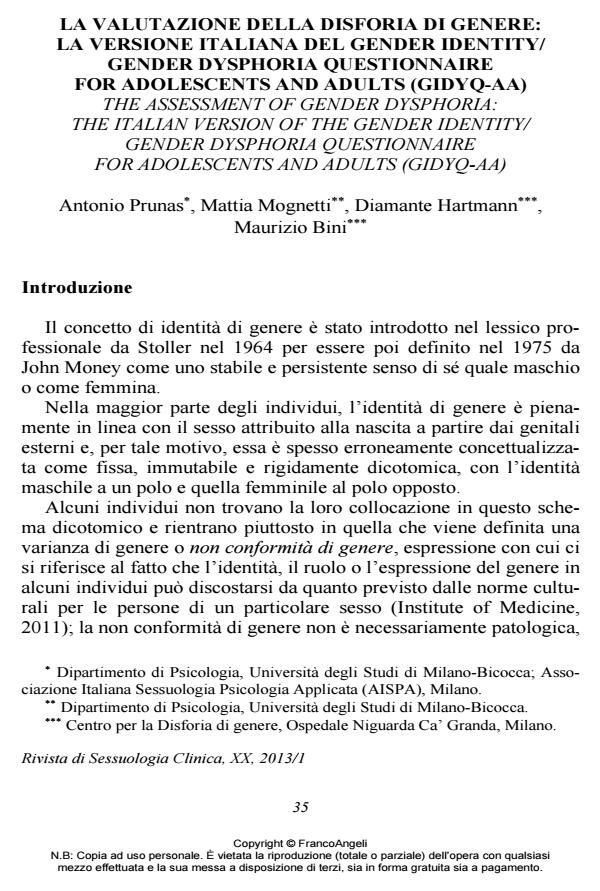La valutazione della disforia di genere: la versione italiana del gender identity/gender dysphoria questionnaire
Titolo Rivista RIVISTA DI SESSUOLOGIA CLINICA
Autori/Curatori Antonio Prunas, Mattia Mognetti, Diamante Hartmann, Maurizio Bini
Anno di pubblicazione 2013 Fascicolo 2013/1
Lingua Italiano Numero pagine 17 P. 35-51 Dimensione file 582 KB
DOI 10.3280/RSC2013-001003
Il DOI è il codice a barre della proprietà intellettuale: per saperne di più
clicca qui
Qui sotto puoi vedere in anteprima la prima pagina di questo articolo.
Se questo articolo ti interessa, lo puoi acquistare (e scaricare in formato pdf) seguendo le facili indicazioni per acquistare il download credit. Acquista Download Credits per scaricare questo Articolo in formato PDF

FrancoAngeli è membro della Publishers International Linking Association, Inc (PILA)associazione indipendente e non profit per facilitare (attraverso i servizi tecnologici implementati da CrossRef.org) l’accesso degli studiosi ai contenuti digitali nelle pubblicazioni professionali e scientifiche
Lo studio esplora le proprietà psicometriche del GIDYQ-AA, un questionario per la rilevazione della Disforia di genere. Viene valutata la struttura fattoriale, le differenze legate all’orientamento sessuale e a Disforia di genere e la relazione con alcune misure criterio quali il funzionamento generale e l’integrazione dell’identità. Metodo: il campione è risultato composto da 207 volontari (84 maschi, 123 femmine) e da pazienti rivoltisi a un centro specializzato nel trattamento della Disforia di genere. Tutti i partecipanti hanno compilato il GIDYQ-AA e una batteria di questionari per rilevare le misure criterio di interesse. Risultati: È emersa una struttura unifattoriale; è stato possibile distinguere il gruppo non clinico sulla base dell’orientamento sessuale e il gruppo di controllo dal campione clinico. Sono emerse associazioni con tutte le misure criterio considerate. Conclusioni: i risultati legittimano l’uso del GIDYQ-AA per la valutazione della Disforia di genere.
Parole chiave:Disforia di genere, assessment, Disturbo dell’identità di genere, Transessualismo, valutazione, screening.
- Esperienze infantili e disforia di genere Maurizio Bini, Diamante Hartmann, Ilaria Montella, Riccardo Morzaniga, Antonio Prunas, in RIVISTA DI SESSUOLOGIA CLINICA 1/2015 pp.5
DOI: 10.3280/RSC2015-001001 - Neural Correlates of Gender Face Perception in Transgender People Alessandra Daphne Fisher, Jiska Ristori, Giovanni Castellini, Carlotta Cocchetti, Emanuele Cassioli, Stefano Orsolini, Carolina Sensi, Alessia Romani, Francesca Mazzoli, Agnese Cipriani, Valdo Ricca, Linda Vignozzi, Maria Pia Viggiano, Mario Mascalchi, Mario Maggi, Gioele Gavazzi, in Journal of Clinical Medicine /2020 pp.1731
DOI: 10.3390/jcm9061731 - Il terapeuta sistemicorelazionale e la popolazione LGBTQIA+: un'analisi delle nuove forme di famiglia Federica Seravelli, Cecilia Caravaggi, Maria Luisa Iervolino, in RIVISTA DI PSICOTERAPIA RELAZIONALE 59/2024 pp.26
DOI: 10.3280/PR2024-059002
Antonio Prunas, Mattia Mognetti, Diamante Hartmann, Maurizio Bini, La valutazione della disforia di genere: la versione italiana del gender identity/gender dysphoria questionnaire in "RIVISTA DI SESSUOLOGIA CLINICA" 1/2013, pp 35-51, DOI: 10.3280/RSC2013-001003